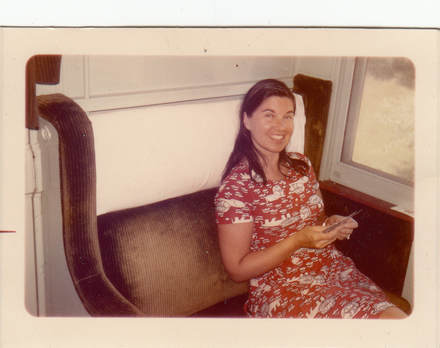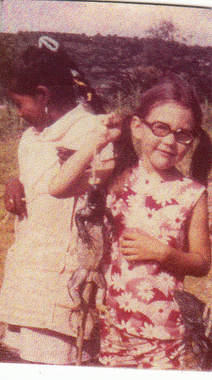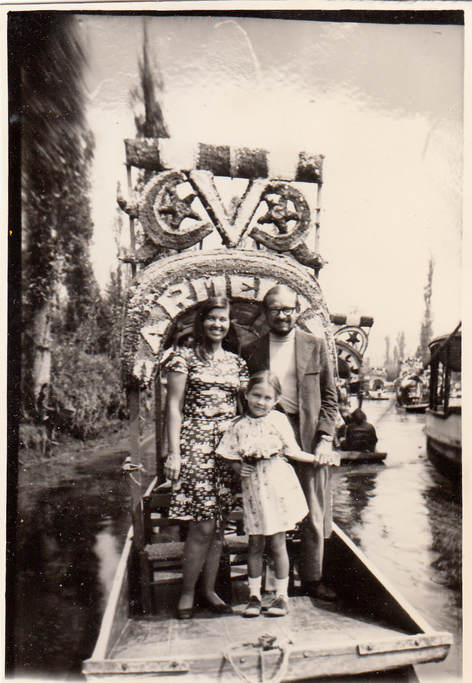
We flew to San Diego and bused to Calexico. That was the easy the part. Then we carried our suitcases across the dusty border to the antique Ferrocarriles Nacionales de Mexico station. Spanish and English collided under the cracked stucco ceiling: Norteamericano turistas and returning Mexicanos, suitcases, boxes, and baskets around their feet, were gathering to wait for a train everybody knew would be late. Eventually, we boarded an aged Pullman car, once part of a streamliner that sped across the United States, now on the way south to Mexico City. That evening when we went to dinner as we rocked over the Sonora desert, our green-upholstered seats were transformed to approximations of beds.
By morning, rattling south across the Tropic of Cancer, we realized that the air-conditioning wasn't working. We weren't sure that it had ever functioned. On the way to the restaurant car, we passed curtained berths being turned back into seats. Later, the car became a combination cantina and hacienda, over-heated people bringing out food and drink to share as we all sweltered and sweat. Eventually, we clattered into Guadalajara, city of golden colonial buildings, ornate churches, and blossoming trees and vines. An art deco observation/bar car was hitched onto the train for the final day and night, streamlined with silver walls, windows with Venetian blinds to blink at whatever it passed, and a sleek bar where we could indulge while the train struggled up to the plateau where Mexico City sprawled. Before we got off, we discovered that our camera had disappeared. Apparently, the safe place where we'd put it hadn't been so safe.
The huge Diego Rivera mural in the lobby of the Hotel del Prado in the heart of the city, lured us into its colorful, fantastic world: the grinning, strolling population in Chapultepec Park, barefoot kids, overdressed bankers, peasant women, vendors hawking balloons, Frida Kahlo and Diego, themselves, musicians and vendors, and upper class ladies in Sunday finery. Best-dressed of all was Madame Death in feathered hat and elegant boa. "Run kiddies, if you can," she seemed to say with her toothy grin. "I'll get you in the end." We also ventured out for a little sightseeing, including a boat ride among the meandering canals and artificial islands of the floating gardens at Xochimilco. Today, pollution and sewage have ruined the beauty of this corner of the city, but then it still was a unique and popular excursion.
Before we left Mexico City, we bought a new camera—not as nice as the missing one, but adequate. A day later, our rental car was churning up the dusty present on the way to Yucatan's colorful past, Sherrill weaving around ambling donkeys and sleeping cows and honking the horn at vultures in the center of the road reluctant to interrupt their meals, feathers and bits of flesh occasionally landing on the hood or windshield.
 Simone and iguana
Simone and iguana In the bathroom, I discovered that the shower sprayed the whole room; the only drain was in the middle of the tile floor.
"What did you do in here?" Sherrill demanded when I came out.
"Just drown a few spiders and bugs."
Simone peered in. "Where are they?"
"Drowned."
Before we left town, we explored some of the hillside shops crowded with silver buckles and broaches, necklaces and bracelets, candlesticks and bowls, and other treasures made by local artisans. Sherrill and Simone got small pins, silver animals that they wore to dinner on a shady terrace. A day later, we were on the way to Acapulco and the Pacific Ocean.
We stayed in a hotel on the Acapulco beachfront so that we could play in the lazy green waves. Back then, the beach and bay were still unspoiled and not yet polluted. That afternoon, we rode out into the bay in a glass-bottom boat. The crew gave the three of us cool drinks in coconuts with straws. Sherrill and I could taste rum in ours. A little later, when Simone began to seem happily groggy, I tasted hers. They'd put rum in it, too.
Sherrill wanted to see Tehuantepec, an historic coastal town known for its loyalty to a matriarchal past. Some of the women still wore the old-time multi-layered white lace dresses because they represented the Zapotec tradition of female power. Women, we saw, dominated the markets, as both sellers and buyers. After another dip in the Pacific, we drove across the isthmus, about 120 miles, to the Gulf of Mexico, where we went into the water again, so we could say that we'd swum in both oceans on the same day.
The winners became gods and the losers were sacrificed: that was the payoff for the game played in the pre-Columbian ball court of Monte Alban. The size of the stone buildings and the elegance of their carving impressed us. Each of these ancient sites, we were discovering, had its own personality. The elaborate stone work of Palenque, still partially covered by jungle, seemed baroque by comparison. Once again, Sherrill was heroic as we drove further into the heat and humidity of Yucatan, the jungle thick around us. Our cheap rental car had no air-conditioning, which didn't make life easier. Then, miles from a garage, jungle stretching on both sides of the narrow steaming road, a rear tire collapsed with a grim lurch and bump. When we'd rented the car, we hadn't thought to check in the trunk for a spare tire or jack. Solemnly, I walked to the back of the car to look.
"They'd better be here," I told a hairy orange tarantula watching me from the gravel at the edge of the road.
"Good luck," he replied. (Or maybe I had sunstroke on coming on.)
To be continued....

 RSS Feed
RSS Feed